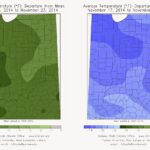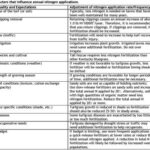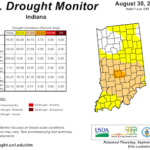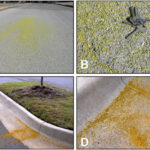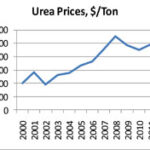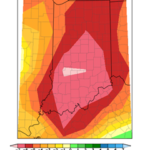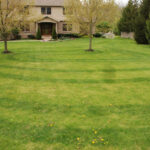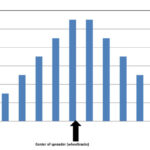Category: Fertilizer
Is it Too Late to Apply My Last Nitrogen Fertilization?
Fall is an important time to fertilizer our cool-season turfgrasses. Fall nitrogen promotes good root development, enhances storage of energy reserves, and extends color retention in cool-season lawns. Most of the benefits from late fall nitrogen will be seen next spring and summer with earlier green-up, improved turf density, and improved tolerance to spring diseases […]
Making Adjustments to Your Fertilizer Program
Although the Purdue University Turf Program publishes information about how to fertilize your turf with nitrogen (N)-based fertilizers including standard rates and timings, there are many factors that influence these rates and timings. It is important that each turf area be fertilized according to its needs. For example, some areas require more nitrogen fertilization because […]
Fall Fertilization
Cool-season turfgrass species should be fertilized mainly in the autumn. September and November are the two best times to fertilize a lawn in Indiana. Fall nitrogen promotes good root development, enhances storage of energy reserves, and extends color retention in cool-season lawns. Most of the benefits from late fall nitrogen will be seen next spring […]
Staying Dry
Many in central Indiana are coping again with drought a second year (See drought monitor images for Indiana (current and fall of 2010). While many pockets of Indiana have had sufficient moisture in the second half of summer (including Lafayette) others are facing dry conditions for a second year in a row. September […]
Spilled Fertilizer: Loading and Application
Fertilizer loading Fill spreaders over a hard surface such as a driveway, sidewalk, or other hard concrete or asphalt surface. This will allow easy clean-up if any material is spilled. Fertilizer spills over turf usually result in turf death to the affected spot. If product is spilled during loading (A), clean-up the material immediately by […]
What is Driving Recent Increases in Fertilizer Prices?
Fertilizer prices are on the upswing again, buoyed by the high prices of agricultural products that have stimulated increased demand. While the general U.S. economy struggles to recover from the financial crisis of 2008, the demand for agricultural products continues in a strong position due to favorable exchange rates, grain usage for biofuels, production concerns […]
Top Ten Turf Tips of 2010
Part II: Summer diseases in Residential Turf Part III: Summer weeds: Common summer weeds and their control Part I: Too hot: Why some turfgrass species look poor in summer Color Variation in Residential and Commercial Lawns Crabgrass Control Now is the time to seed lawns and other turf areas Choosing a Preemergence Herbicide Late Fall […]
Late Drought Causing Problems and Questions for Many
Earlier this fall we made recommendations on how to recuperate lawns after a drought; however, rain has not returned and now we must further adjust our maintenance practices in unirrigated turf areas. The map on the left shows the lack of rainfall in Indiana over the past 90 days. The majority of Indiana has received […]
Late Fall fertilization
Cool-season turfgrass species should be fertilized mainly in the autumn. In addition to a fertilization in September, a fertilization with nitrogen in November will help produce a healthy turf. Lawns damaged during summer months as in 2010 and newly seeded lawns may need this November fertilization to help with recovery and the establishment of new […]
Fertilizer Recommendations
The amount of nitrogen fertilizer required by turf depends on various management and environmental/management factors (Table 1). A good rule to follow is to never apply more than 1.0 lb N/1000ft2 in any one application. Do not apply fertilizer more frequently than once monthly at a 1.0 lb N/1000ft2 unless you are establishing a new […]
May Fertilization
Although it is generally preferable to fertilize home lawns in the fall, a late May fertilizer application can help the turf retain its color and vigor during the summer. If conservative nitrogen rates are used, fertilizer can be applied in late spring without dramatically increasing vertical growth. To aid the turf in keeping its color […]
Calculating the pounds of fertilizer to apply
There are literally thousands of fertilizers and fertilizer/pesticide combinations available to homeowners and professionals. Therefore, we can’t recommend how many pounds of a specific fertilizer to apply, but rather we must recommend fertilization rates in pounds of nitrogen per thousand square feet or lbs N/1000ft2. You can use our fertilizer calculator at http://www.agry.purdue.edu/turf/fertcalc/Fertilization%20calc.html or you can use […]
Turf 101: Why does a November application of fertilizer work?
Nitrogen stimulates increased photosynthesis and the extra energy derived from this goes directly into growth, respiration to maintain the plant (similar to humans), or into storage. In early November, the temperature is still adequate for photosynthesis, but cool enough to minimize respiration demands and too cold for significant growth. Therefore, most of the extra energy […]
Professionals Only: Dry weather hampers broadleaf weed control, fertilization
Though we are now in the window for maximum broadleaf weed control and fall fertilization, the dry weather throughout most of the state is hampering applications. Avoid herbicide and/or fertilizer application to drought stressed or dormant turf to limit turf damage and maximize intended effect of the application. On turf that’s still green (like in […]
Cool temperatures allow a jump on beneficial fall maintenance practices
The recent record or near record low temperatures combine with adequate soil moisture is advantageous for our cool-season turfgrasses, especially compared to the typical August-September heat and drought. Fall fertilization can begin anytime, especially with rain in the forecast to help water in the application. White grub damage will likely be minimal with overall health […]
Summer Mowing and Fertilization
By the time you read these words the longest day of the year has approached and the official calendar “Summer” season will have begun. Just as the weather changes as we transition between seasons from late-Spring to Summer the turfgrass plant changes too. First, both air and soil temperatures rise beyond what is optimal for […]
Responsible fertilization of home lawns
A properly fertilized turf has fewer weeds, is more resistant to insects and disease, and decreases water runoff compared to malnourished turf. Concern over the negative effects of nutrient enrichment on water quality is a growing public concern and has led many to start to question turfgrass fertilization practices. Although both nitrogen and phosphorus may […]
Spacing between passes with a rotary spreader
Rotary spreaders are widely used by homeowners and professionals for most applying fertilizers and pesticides. So to test your knowledge, here’s a question that I constantly ask of professionals and do-it-yourselfers when spreading fertilizer back and forth on a turf area: A. Your current pass should spread product so it just touches the edge of the […]
Turf 101: Limit Spring Fertilization
Many different strategies exist on spring fertilization, but the one fact agreed upon by all turf specialists is to avoid applying heavy nitrogen (N) rates in March or April. Heavy rates would be anything greater than 0.75 lbs of quickly available N/1000 ft2, which causes excessive shoot growth and results in frequent mowing. Furthermore, excess […]
Calculating the pounds of fertilizer to apply
There are literally thousands of fertilizers and fertilizer/pesticide combinations available to homeowners and professionals. Therefore, we can’t recommend how many pounds of a specific fertilizer to apply, but rather we must recommend fertilization rates in pounds of nitrogen per thousand square feet or lbs N/1000 sq ft. You can use our fertilizer calculator at www.agry.purdue.edu/turf/fertcalc/Fertilization%20calc.html […]
